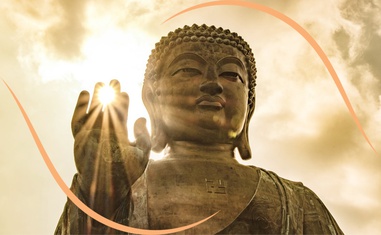The views expressed in our content reflect individual perspectives and do not represent the authoritative views of the Baha'i Faith.
We can learn a lot about religion from its cultural objects, and the images associated with Buddhism offer an important and essential mythology that can teach us quite a bit.
The dominant symbol in Buddhism is clearly the Buddha himself in various poses, usually sitting with eyes partially closed, but in the Japanese Hotai versions, standing and laughing. This laughing version, probably modeled after a corpulent Chinese Buddhist monk known for his happiness and generosity, is nevertheless understood as a representation of the Buddha. These kinds of images hold important lessons for us.
RELATED: Was Buddha ‘Just a Man’ or Was He a Prophet?
The serene meditating Buddha obviously shows spiritual illumination as an inner process. Yes, social forces may promote it, but spiritual awakening is always an individual psychological undertaking. It can thus be accessed by anyone, and the image of the Buddha shows how: by simply sitting, detaching ourselves from distractions, and attending to what is already within us — the kingdom of God, the source of all being, empty of anything else we could add to it.
This Buddhist mindfulness, so beautifully captured in the image of the meditating Buddha, shows us our linkage to an extremely powerful force and source of wisdom and compassion, if we become mindful of it.
The laughing Buddha also has an important lesson to teach us: that there is bliss — the Buddha nature — hidden in everything, waiting to be revealed. All creation is holy and more than it seems — it only requires our perception to see it.
These two images and their variants model for us how close the eternal world is, how easy it is to attain, how much it has to offer and how we are connected to it. These are profound recognitions, easy for fair-minded people to accept, and one reason why the contributions of Buddhism to spiritual civilization, both in the East and the West, cannot be written off.
We need the Buddha’s message.
But the Buddha’s message is not in opposition to the message of the cross, or the Qur’an, or the Hebrew Bible, or the core of Hindu scripture. All are attempts to rescue humans from social and self-destruction. It is true that we cannot serve different masters and remain sane — but if those masters reflect a common will, there is no conflict.
The principles of oneness and unity in the Baha’i Faith say we can learn from all religions, accept their prophets and their teachings as part of one divine plan, and thereby enjoy an enriched understanding of God’s workings by participating in healing the world. Baha’u’llah, the prophet and founder of the Baha’i Faith, explained that concept in these terms:
The Prophets of God should be regarded as physicians whose task is to foster the well-being of the world and its peoples, that, through the spirit of oneness, they may heal the sickness of a divided humanity. … every time the Prophets of God have illumined the world with the resplendent radiance of the Day Star of Divine knowledge, they have invariably summoned its peoples to embrace the light of God through such means as best befitted the exigencies of the age in which they appeared. They were thus able to scatter the darkness of ignorance, and to shed upon the world the glory of their own knowledge. It is towards the inmost essence of these Prophets, therefore, that the eye of every man of discernment must be directed, inasmuch as their one and only purpose hath always been to guide the erring, and give peace to the afflicted ….
This sequence of prophets and their religions fits into a larger pattern and plan, which Baha’is call progressive revelation. That means religion continually evolves over time, and also explains the rise and the decline of each individual Faith. Religions must periodically be renewed, the Baha’i teachings explain, and Buddhism is no exception.
RELATED: How to Accept All the Prophets of God as One
Why Buddhism Needs Renewal
The Buddhist scriptures contain a divine promise — that when things got bad, a new Buddha named Maitreya (Metteyya, Pāli) would be sent to restore morality and longevity. The verses go on to explain how each new vice that people adopt — speaking evil of another, harsh speech and idle chatter, false opinions, lack of respect, adultery, incest, excessive greed and deviant practices — would cut lifespan from fantastic lengths, starting at 80,000 years, to 10 years.
Given the obviously metaphorical nature of these lifespans, the clear point seems to be that vice and falsehoods shorten and imperil life, and both individual and social renewal is needed for human progress to restart. Humanity needs a great teacher, a chosen one of God, to provide this re-start.
Many Buddhist societies around the world are in need of renewal, but so are all societies. New problems, some never before seen, are appearing at alarming rates. Where is our Maitreya, our new Avatar, our Qa’im, our Jesus with a new name, and our Messiah?
The Baha’i teachings say that those prophecies have all been fulfilled by Baha’u’llah. Shoghi Effendi, the Guardian of the Baha’i Faith, summarizing its major teachings and principles for the United Nations in 1947, wrote:
The aim of Baha’u’llah, the Prophet of this new and great age which humanity has entered upon — He whose advent fulfils the prophecies of the Old and New Testaments as well as those of the Qur’an regarding the coming of the Promised One in the end of time, on the Day of Judgment — is not to destroy but to fulfill the Revelations of the past, to reconcile rather than accentuate the divergences of the conflicting creeds which disrupt present-day society.
His purpose, far from belittling the station of the Prophets gone before Him or of whittling down their teachings, is to restate the basic truths which these teachings enshrine in a manner that would conform to the needs, and be in consonance with the capacity, and be applicable to the problems, the ills and perplexities, of the age in which we live.
So the renovation is underway, but is still largely undetected. To see its outlines more clearly, we turn in the next essays in this series to religions that began in the Middle East, as these build on each other and add progressive detail which explains how the human spirit can coherently respond to current forces and events.

















Comments
Sign in or create an account
Continue with Facebookor